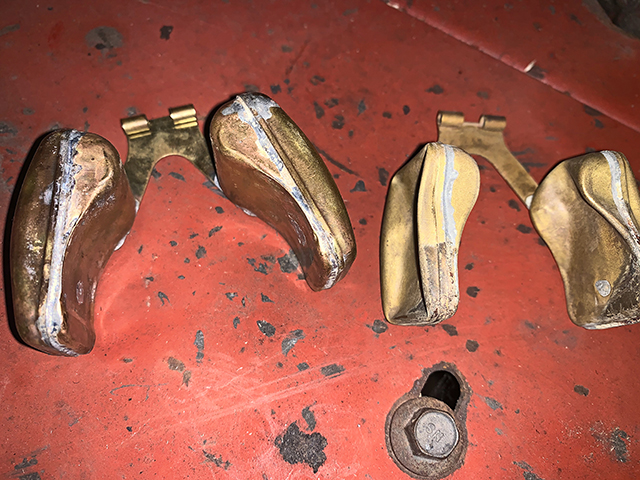Ask the Mechanic
Ice Crushes Floats
READER: I have a 640 Ford gas tractor that has a carburetor problem. It floods, drips gas, knocks out spark plugs. I have tried to repair the carburetor myself but have put two complete kits in it, and it still has the same problem. I took it to a garage, and they soaked it in cleaner and put a kit in it. It still floods a stream, and there seems to be nothing dirty in the tank, carburetor or under the needle and seat. I could buy a new carburetor, but I want to keep the original carburetor on the tractor if at all possible. Do you have any ideas?
STEVE: The carburetor on your tractor is known as an updraft carburetor. With this style carburetor, the engine has to suck the fuel "up" into the intake manifold. Since the carburetor on this tractor is many times gravity fed, the needle and seat are constantly under fuel pressure. What controls the needle and seat to allow fuel to remain at a constant level while the engine is either running or shut down is the float working against the needle and seat. Just like a toilet, the float on most toilets allows water to enter when you flush, but it also shuts the water off after it fills. The float in your carburetor is probably the problem. What I believe you will find is a collapsed float. When the float is collapsed, it loses its power to shut tightly the needle in the seat. What made it collapse? It sounds crazy, but it's really simple. At some time, the carburetor had water in it that was frozen. The area in the bowl of the carburetor is very small, as the float takes up most of the space. Therefore, it does not take much water to fill the bowl to crush the float when the water is frozen. Since the float wall material collapses under pressure before the carburetor casting cracks, most of the time the carburetor is not damaged. If you have never seen a normal float beside a crushed float, it's easy to just put it back in a rebuild kit that does not come with a new float. So, if your carburetor floods, check the float, and if your toilet floods, check your float in your toilet.
P[L1] D[0x0] M[300x250] OOP[F] ADUNIT[] T[]
READER: I have a John Deere 705 twin bar hydraulic rake. It has been a good rake and works great no matter the field or hay condition. However, when using the rake on my TN75 New Holland tractor, the hydraulic oil gets hot. How hot I do not know, but it gets hot enough that I have to get off my platform tractor after a couple of hours of use. I had to put a flow restrictor in the reel drive hose to slow down the rake. There is a warning label on the rake that warns that overheating of hydraulic oil could be a problem. I found out that the rake was built by Vermeer for John Deere, so I gave them a call for help. They told me that hotter-than-normal oil is normal when running hydraulic motors. I think the oil is too hot. I like the tractor and rake, so can you tell me how to make them a happy team together?
STEVE: Your heating problem is not that uncommon when running hydraulic motors. Most of the heat comes from the fact that your tractor's hydraulic pump provides many more gallons per minute (gpm) than the rake motors need to run. Your TN75 hydraulic pump will deliver 16.9 gpm at PTO speed, but your rake normally only needs around 6 gpm to rake hay. So, what happens to the rest of the oil? It is restricted, which is a big heat builder, especially if the excess oil is going over relief. Since your tractor's hydraulic system only holds 11.1 gallons, the oil has little time to cool during a total circulation. The pump in your tractor puts out more gpm as the engine speed increases, which is very common in your tractor's open-center system that keeps oil circulating in the hydraulic system all the time. Many newer open-center tractors come with a flow-control valve that routes excessive oil back into the tractor. This adjustable control valve allows an open-center system to control oil flow to the hydraulic motors, eliminating many of the heating problems. Shoup Manufacturing offers an adjustable flow-control valve to help your heating problem for around $100. For those who are using a tractor with a closed-center system (pump adjusts to hold a predetermined pressure), to eliminate heat, simply adjust your service control valve to deliver an amount just enough to run the rake as fast as you desire. And, yes, you can even adjust the older John Deere closed-center tractors with the control valve under the cowling to deliver oil only as needed to help with a heating problem.
SAFETY TIP OF THE MONTH:
Be careful when using a large hub puller to remove a tapered and spline-designed hub. The puller and hub can pop off fast and injure your leg or any body part in its way when the puller shoots off with the hub. The axle hub nut, even on an old 8N Ford rear axle, calls for 400 foot-pounds of torque. This high torque, plus a little rust, turns the puller and hub into a missile when they dart off the axle under no resistance.
**
> Write Steve Thompson at Ask The Mechanic, 2204 Lakeshore Dr., Suite 415, Birmingham, AL 35209, or email mechanic@progressivefarmer.com.
[PF_0321]
(c) Copyright 2021 DTN, LLC. All rights reserved.




